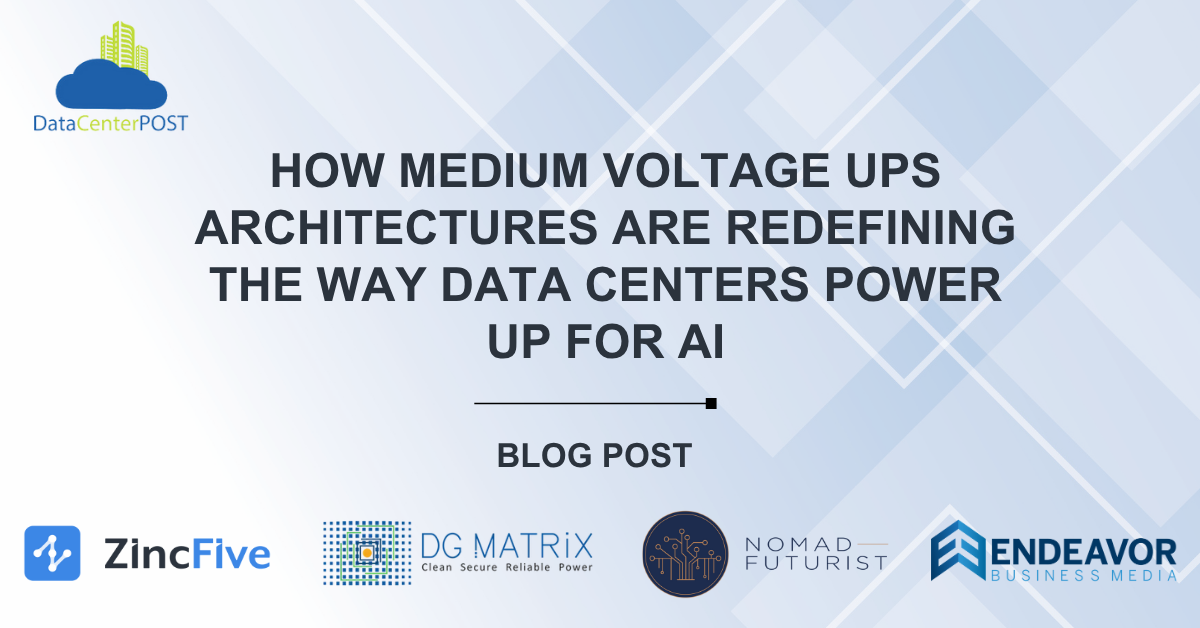Artificial intelligence is reshaping the digital infrastructure landscape, driving unprecedented increases in data center power density. The rise of “AI factories”, massive clusters of GPUs training and running large-scale models, has brought new challenges to the forefront of facility design. From sudden load spikes to the limits of traditional low-voltage architectures, the industry is rethinking how to deliver reliable, safe, and sustainable power.
This was the focus of recent conversations featured on The Data Center Frontier Show at the 2025 Data Center Frontier Trends Summit, where experts from ZincFive and DG Matrix shared their perspectives on what comes next.
Why Medium Voltage UPS Matters
As AI racks move from 100 kW to 600 kW and even 1 MW each, traditional low-voltage UPS systems are reaching their ceiling. Medium-voltage (MV) UPS architectures, operating at 4.16 kV or higher, are emerging as a practical solution.
MV systems reduce distribution losses, free up valuable floor space, and improve overall efficiency. “Every percentage point saved in UPS efficiency at these scales translates into megawatts reclaimed,” noted ZincFive’s Mike Klassen. The benefits go beyond efficiency. Less heat generation, smaller conductors, and safer operations all contribute to more resilient facilities.
Tackling Dynamic Power Loads
One of the biggest challenges in AI data centers is the volatility of GPU power usage. Racks can swing from 10% of their nominal load to 180% in milliseconds, sending disruptive transients rippling through the power chain.
“Those spikes have to go somewhere,” explained DG Matrix’s Sugam Patel. “If you let them propagate, they stress every part of the system from UPS to gensets. The best way to handle them is right at the source.”
ZincFive’s nickel-zinc battery systems, combined with DG Matrix’s solid-state transformers and power routers, offer a path forward. By absorbing spikes locally, they smooth the load profile before it impacts upstream infrastructure. The result is improved stability for utilities, data center operators, and end users alike.
Sustainability and Safety at Scale
Beyond performance, sustainability is a driving concern. AI-scale UPS solutions must not only be efficient but also safe and environmentally responsible. Nickel-zinc batteries deliver shorter-duration backup (measured in minutes, not hours) that aligns with real-world data center needs while avoiding the fire risks associated with lithium-ion.
As Klassen put it, “Data centers don’t need five-hour batteries. They need five-minute batteries that are safe, reliable, and compact.”
Looking Ahead
The consensus among the experts is clear: AI and high-performance computing will continue to push data centers beyond conventional design envelopes. Medium-voltage UPS and localized power smoothing aren’t niche fixes, they represent a directional shift in how the industry will meet the next decade of growth.
Flexibility and collaboration will be key. By pairing innovative battery chemistries with modular, utility-aware architectures, operators can build AI-ready campuses that are both resilient and sustainable.
AI isn’t just transforming software and services. It’s redefining the physical backbone of the digital world. As power densities surge and variability increases, the way data centers manage electricity is becoming as strategic as the compute they deliver. The industry’s shift toward MV UPS and dynamic load management solutions marks the beginning of a new era in infrastructure design, one where efficiency, safety, and sustainability are as critical as raw power.
Click here to listen to the full podcast.


